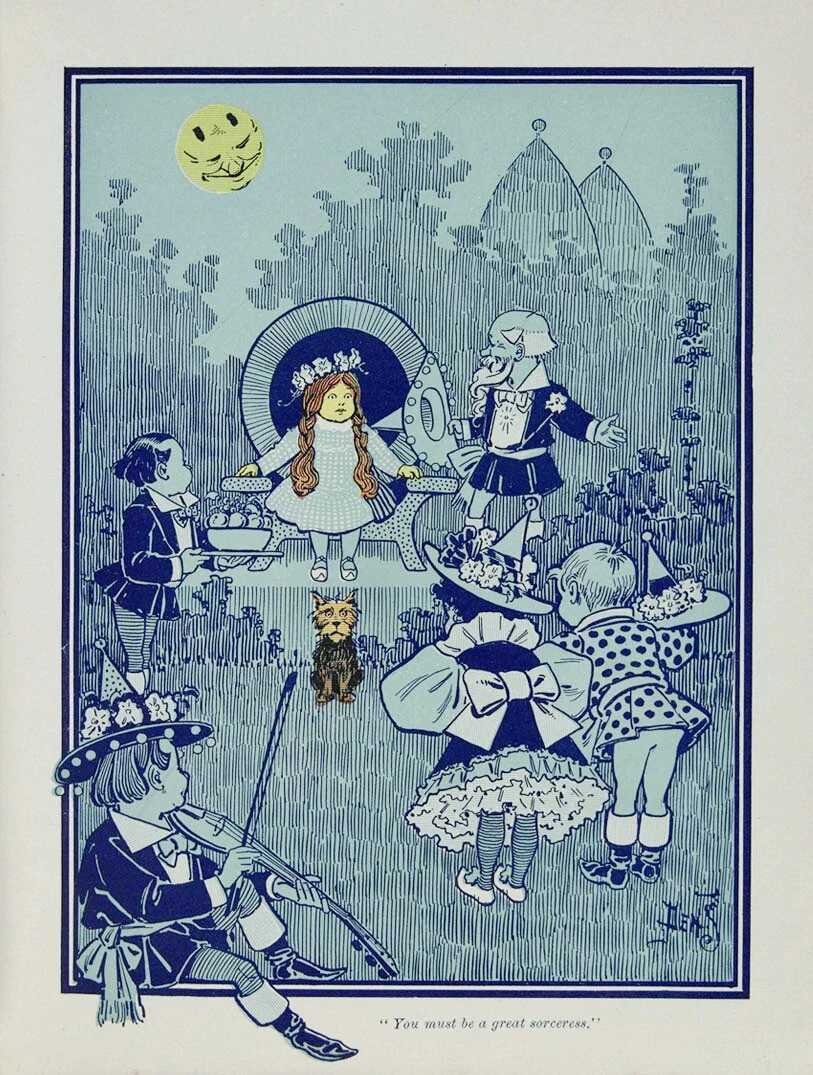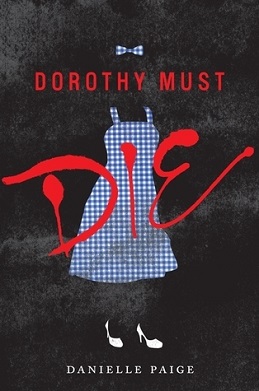I've written before about the world of Oz as created by Lyman Frank Baum. The setting has several appealing aspects for campaign building, including the fact that it's a well-known universe, much of it is public domain, and it ties together a bunch of different genres. In short, if you're looking for a non-traditional replacement for the Feywild, Oz is a great place to start. Also, Santa Claus lives there. More on him later.

Baum started out as a theater producer and playwright, but found success in publishing children's literature. All the while, he kept working on producing films and plays. He wrote 14 novels in the Oz series, plus over 40 other novels, over 80 short stories, and more than 40 scripts. For Baum, Oz was the beginning but never the end of his vision. Baum regularly turned theatrical and movie scripts into books when they didn't gain traction on screen or in the theater, like The Marvelous Land of Oz and Tik-Tok of Oz.
But Baum always had bigger plans. He wrote about the absurd land of The Magical Monarch of Mo, of two children visiting a fairyland in Dot and Tot of Merryland, gave Santa a backstory in The Life and Adventures of Santa Claus, followed the adventures of a gingerbread man come to life in John Dough and the Cherub, and warned about what happens when you get your wish in Queen Zixi of Ix. When those books didn't perform well, he placed all three worlds back into the same universe as Oz with his book, The Road to Oz, in which Santa Claus, King Bud and Princess Fluff (from Queen Zixi of Ix), and John Dough show up for the festivities. Later, Baum would try to escape Oz again with the adventures of Trot and Cap'n Bill in The Sea Fairies and Sky Island, but when those books underperformed, the two main characters landed in Oz in The Scarecrow of Oz. All together, these realms created the foundation for Nonestica, a made-up term drawn from the surrounding Nonestic Ocean mentioned in the Oz books.
Baum's fans took things further, adding kingdoms from his other fairy tales, specifically American Fairy Tales, which featured the story "The Queen of Quok." That story adds more kingdoms (Bilkon, Junkum, Mulgravia, and Macvelt), and with a few other short stories from Baum, rounds out the other lands on the fan-made map of Nonestica. Adding to this diverse landscape are the 26 books set in Oz that are currently in the public domain, which flesh out the four corners of that Empire.
Despite the fact that Oz books were very popular in their day, little after The Wizard of Oz is familiar to modern audiences. There's an entire shared realm outside of Oz that's just waiting to be fleshed out by enterprising Game Masters.
Nonestica is a hodgepodge of ideas and it shows on the map. The borders within and outside of Oz aren't particularly logical (they don't follow geographic contours), because they were made up and added as Baum (and later his successor, Ruth Plumly Thompson) wrote more books. It was not uncommon for a new species or kingdom to be introduced and never be mentioned again.
This dreamlike quality makes Nonestica a fluid place that lends itself to the concept of domains. We've seen domains used to good effect in Van Richten's Guide to Ravenloft, but there are hints that the same premise will be applied to the Feywild with the upcoming book. The Wild Beyond the Witchlight mentions "Domains of Delight," a similar concept with lands that can open and close their borders and even move around as the game master sees fit.
Nonestica also encompasses a variety of genres. There are steampunk-style giants invented by the King of Scowleyow (from Mo), an island populated by failed inventions (the Isle of Phreex from John Dough), sea fairies battling fiendish monsters in the Nonestic Ocean (from The Sea Fairies), an academy of witches in Ribdil, Santa Claus' workshop in Hohaho Valley, and even a demon portal that spawns awgwas who bedevil the jolly old elf. There's just enough rough outlines to use Oz tropes in different lands.
That diversity goes beyond the surface and extends to the sky, where numerous "skylands" are detailed, from the pink-vs.-blue divided Sky Island to the militaristic Airlanders who possess blasting horns, gunpowder, and flying staves. There's much below ground too, including the Kingdom of the Nomes (a lot like D&D's dwarves), and a multitude of "hollow world" realms that exist in their own ecosystems, like that of the plant-like mangaboos, the silver people of the isles, and the burrowing flamefolk who live in lava.
Substituting Nonestica as a fairy land to replace the traditional Fey lands usually associated with Seelie and Unseelie has its own hazards. But with a few tweaks, you can add Nonestica to your game.
Your Turn: What books have you adapted to your campaign?
The Wonderful World of Baum
If your only knowledge of Oz is the Wizard of Oz movie, you're in good company. And by all accounts, multimedia was always Baum's plan.Baum started out as a theater producer and playwright, but found success in publishing children's literature. All the while, he kept working on producing films and plays. He wrote 14 novels in the Oz series, plus over 40 other novels, over 80 short stories, and more than 40 scripts. For Baum, Oz was the beginning but never the end of his vision. Baum regularly turned theatrical and movie scripts into books when they didn't gain traction on screen or in the theater, like The Marvelous Land of Oz and Tik-Tok of Oz.
But Baum always had bigger plans. He wrote about the absurd land of The Magical Monarch of Mo, of two children visiting a fairyland in Dot and Tot of Merryland, gave Santa a backstory in The Life and Adventures of Santa Claus, followed the adventures of a gingerbread man come to life in John Dough and the Cherub, and warned about what happens when you get your wish in Queen Zixi of Ix. When those books didn't perform well, he placed all three worlds back into the same universe as Oz with his book, The Road to Oz, in which Santa Claus, King Bud and Princess Fluff (from Queen Zixi of Ix), and John Dough show up for the festivities. Later, Baum would try to escape Oz again with the adventures of Trot and Cap'n Bill in The Sea Fairies and Sky Island, but when those books underperformed, the two main characters landed in Oz in The Scarecrow of Oz. All together, these realms created the foundation for Nonestica, a made-up term drawn from the surrounding Nonestic Ocean mentioned in the Oz books.
Baum's fans took things further, adding kingdoms from his other fairy tales, specifically American Fairy Tales, which featured the story "The Queen of Quok." That story adds more kingdoms (Bilkon, Junkum, Mulgravia, and Macvelt), and with a few other short stories from Baum, rounds out the other lands on the fan-made map of Nonestica. Adding to this diverse landscape are the 26 books set in Oz that are currently in the public domain, which flesh out the four corners of that Empire.
Despite the fact that Oz books were very popular in their day, little after The Wizard of Oz is familiar to modern audiences. There's an entire shared realm outside of Oz that's just waiting to be fleshed out by enterprising Game Masters.
Putting it All Together
I recently published my own Oz campaign supplement for Fifth Edition and there's an even bigger book funded by Kickstarter on its way from Double Critical. It's a lot of work to tie it all together, and not all of Oz hangs together naturally without some effort.Nonestica is a hodgepodge of ideas and it shows on the map. The borders within and outside of Oz aren't particularly logical (they don't follow geographic contours), because they were made up and added as Baum (and later his successor, Ruth Plumly Thompson) wrote more books. It was not uncommon for a new species or kingdom to be introduced and never be mentioned again.
This dreamlike quality makes Nonestica a fluid place that lends itself to the concept of domains. We've seen domains used to good effect in Van Richten's Guide to Ravenloft, but there are hints that the same premise will be applied to the Feywild with the upcoming book. The Wild Beyond the Witchlight mentions "Domains of Delight," a similar concept with lands that can open and close their borders and even move around as the game master sees fit.
Nonestica also encompasses a variety of genres. There are steampunk-style giants invented by the King of Scowleyow (from Mo), an island populated by failed inventions (the Isle of Phreex from John Dough), sea fairies battling fiendish monsters in the Nonestic Ocean (from The Sea Fairies), an academy of witches in Ribdil, Santa Claus' workshop in Hohaho Valley, and even a demon portal that spawns awgwas who bedevil the jolly old elf. There's just enough rough outlines to use Oz tropes in different lands.
That diversity goes beyond the surface and extends to the sky, where numerous "skylands" are detailed, from the pink-vs.-blue divided Sky Island to the militaristic Airlanders who possess blasting horns, gunpowder, and flying staves. There's much below ground too, including the Kingdom of the Nomes (a lot like D&D's dwarves), and a multitude of "hollow world" realms that exist in their own ecosystems, like that of the plant-like mangaboos, the silver people of the isles, and the burrowing flamefolk who live in lava.
Substituting Nonestica as a fairy land to replace the traditional Fey lands usually associated with Seelie and Unseelie has its own hazards. But with a few tweaks, you can add Nonestica to your game.
- A Nonestican Campaign: Nonestica is so diverse that an entire campaign can easily be set within its confines. Because new domains within Faerie pop up all the time, it's possible that Nonestica contains your campaign rather than the other way around.
- The Nonestica Continent: Although Oz was often positioned as being somewhere else, it was possible to physically reach it from the modern day world: Dorothy's house was picked up by a cyclone and the Wizard's balloon landed there. As other authors added to Oz's mythology, characters arrived in other ways (such as falling down through the earth). Oz could potentially be a magically-protected continent in your fantasy world.
- Another Plane of Existence: The easiest solution is to just make Nonestica its own plane of existence. Many elements of Oz's geography moved around or contradicted themselves; using domains and borders, this fluidity can be more easily explained. There are several magic items in Faerie that allow transportation across worlds; often, characters stumble upon a powerful magic item or spell without recognizing what it does, only to accidentally use it to transport to Faerie.
- A Dreamland: The Wizard of Oz movie positioned the realm as being part of a dreamscape. Characters might arrive via the Dreamlands into Oz, leaving only when they awaken.
Your Turn: What books have you adapted to your campaign?






